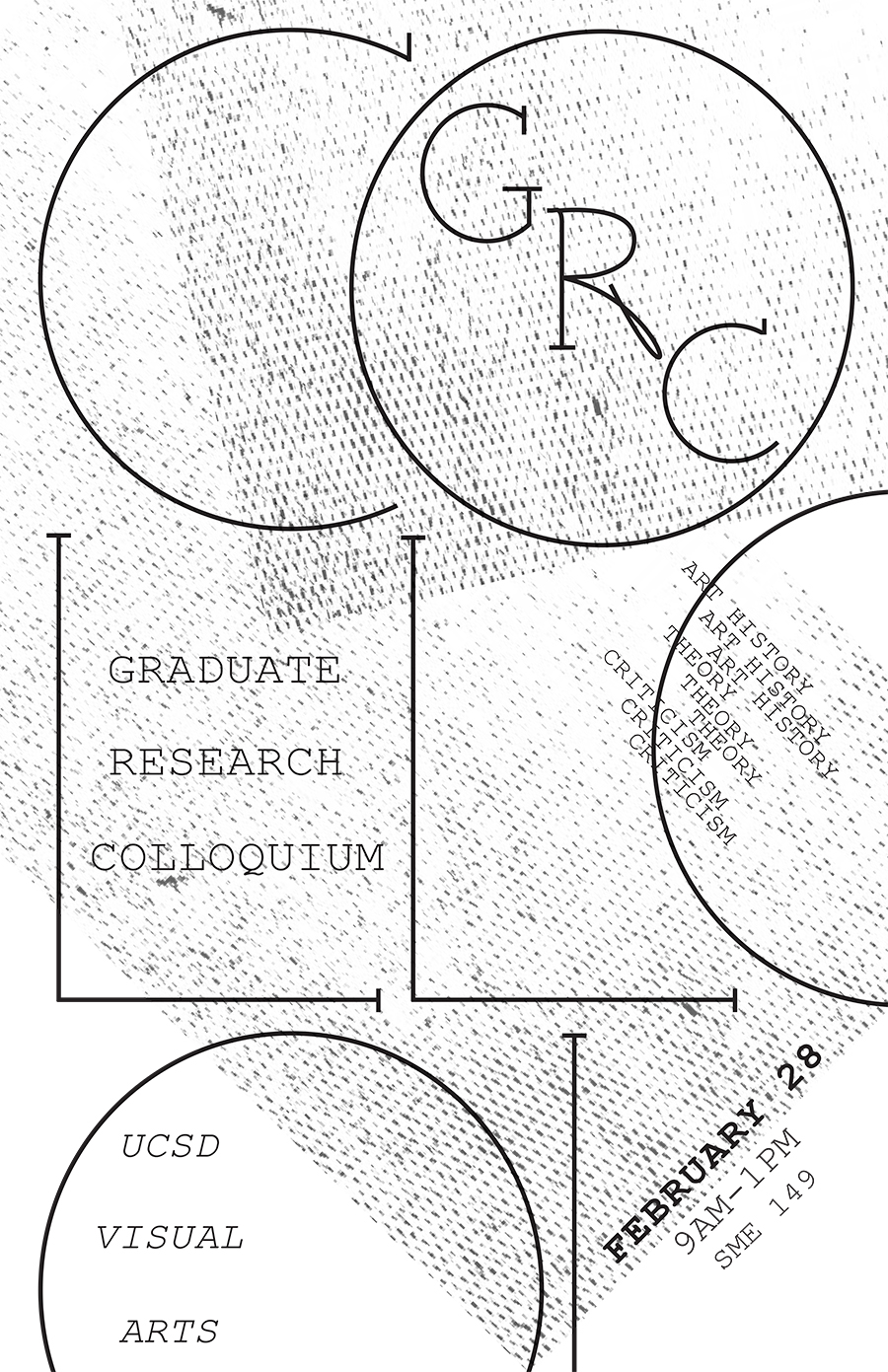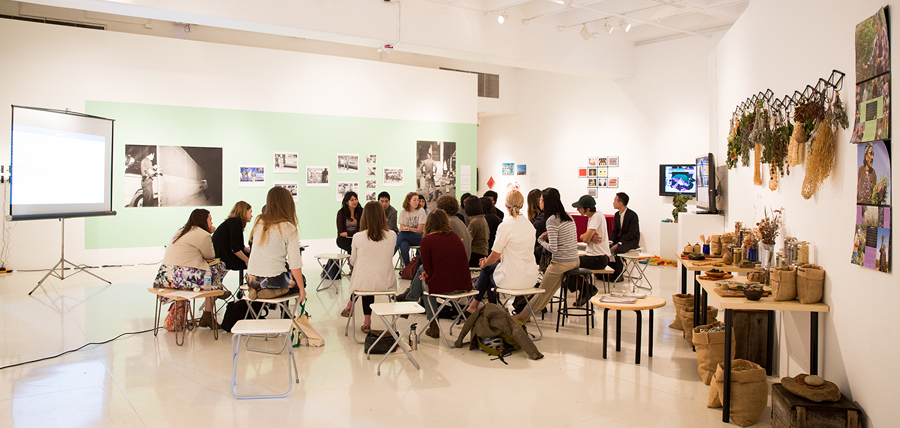Graduate Research Colloquium
PhD Program in Art History, Theory, and Criticism
February 28, 2020, 9 a.m. - 1 p.m.
SME 149, Structural & Materials Engineering Bldg., UC San Diego
Many PhD students are actively engaged in presenting their research to a wider world at conferences and symposia at other universities – but not their home institutions. The Graduate Research Colloquium is meant to overcome this atomization or privatization of intellectual work, in a forum where the excitement and energy of individual projects can become known inside the local community. Advisors will briefly introduce and provide their own reflections on the project, since the Advisor is in a unique position to see where the project lies in relation to the wider field, and to describe the contribution the project will make to the discipline as a whole.
9:00 Introduction: Professor Norman Bryson
9:15-9:45 Session 1: Brianne Itaya
“Maya Ceramics: Past and Present”
My dissertation project focuses on a broad period of time roughly organized into two temporal parts. The first section considers Classic Maya (250-900 CE) polychrome ceramics, addressing notions of materiality, embodiment, personhood, and animacy. I seek to explore the function of elite ceramics in relation to the body and propagate the claim that these ceramics, through their making, use, and decoration, transform into animate embodiments of their owners. In the second section, I shift my focus towards contemporary Maya potters who make replicas of the ancient vessels as well as more original works, creating new imaginings of ancient painting styles. This last section considers the role ceramics play in the formation of Maya identity today.
Tying together these seemingly disparate temporal periods – classic and contemporary – is the notion of object itinerary, a term coined by Rosemary Joyce and Susan Gillespie that expands the idea of object biography and identifies the active quality of objects, liberating them from the confines of the past. Such a notion allows us to think not only about how ceramics were made, conceived, and utilized in their original context, but also how they adopt and adapt through time and space. They are dynamic, adjusting to new contexts, adopting new meaning and significance, and persistently exerting their agency throughout their journeys. Moreover, positioning Maya ceramics as objects in motion allows us to recognize, engage with, and think through their often times illicit, unknown, ambiguous past that is riddled with holes of missing information.
Respondent: Professor Elizabeth Newsome
Brianne Itaya studies the art of ancient Mesoamerica with an emphasis on Classic period Maya ceramics. She has traveled extensively throughout the Maya region, studying Yucatec Maya and befriending potters, artists, and artisans working in these areas.
9:45-10:15 Session 2: Philomena Lopez-Rivas
“A Critical Account of Charles Bojorquez’s Graffiti Art in Los Angeles”
This research inquiry focuses on a photograph that captures Charles Bojorquez in the act of painting in 1975. The photograph features two writing columns known as placas juxtaposed with a 5’x 6’ spray-painted image of the stencil, “Señor Suerte”. Bojorquez attributes placas to pachucos from the 1940’s and understands these written documents as representing a form of solidarity.
“Señor Suerte” is an illustration of a skeleton lavishly accessorized with a wide brimmed hat stretching out from its face and a fur wrap draping over its clavicle. The skeleton with a grimacing smile points with two crossed fingers to its hallow eye sockets. The image of “Señor Suerte” is fragmented into three distinct spaces with respective reproduction techniques, meaning attributed by different audiences, circulation, and asserted value. The image has three surfaces and circuits to consider: walls of the public space, flesh on the bodies of members from a particular gang, and on canvas. The original 1969 location is on the staircase of the Arroyo Seco Parkway where Charles Bojorquez first spray painted the image. Images reproduced by the artist are fragmentations of the original image. The second iteration is a tattoo on the flesh of those who identify with the gang The Avenues; reproduction and circulation of the image occurs parallel to the prison industrial complex by unknown materials, tools, and producers. The third form of fragmentation is as a painting produced by the artist himself on canvas that is either held in private collections or acquired and exhibited in art institutions.
Respondent: Professor Mariana Wardwell
Philomena Lopez studies Chicana/o, U.S. Latinx, and Latin American art. She has worked and interned at various art institutions including Queens Museum, Fowler Museum at UCLA, Hammer Museum, and Armory Center for the Arts.
10:15-10:45 Session 3: Marianna Hovhannisyan
“The New Old is the Old New: Ethnography, the Soviet State, and the Avant-garde”
My presentation will look at the revolutionary projects of the Soviet/Bolshevik state and the historic Avant-garde. Although radically different in their inspirations, both highlighted a programmatic approach to ethnographic knowledge. This approach allowed the state, especially through the culture of the Museum, to picture the different nationalities, nations and ethnicities of the Soviet Union either as new formations (such as “new” Soviet Republics) or as pre-modern enclaves ready for modernization; while ethnography and folklore provided a principal means through which artists of the Russian avant-garde developed a visual language adequate to modernity.
As case studies, my presentation this will briefly discuss the direction of curatorial activity in the USSR from the 1920s to the 1930s, especially in terms of archival and collecting practices. Reflecting on this history from the viewpoint of today, I will argue that the reenactment of the revolutionary tandem of curating, collecting, and ethnography helps to reimagine both representative and discursive frameworks of race, ethnicity, and nations in the digital and post-conflict contemporary world.
Respondent: Professor Norman Bryson
Marianna Hovhannisyan is a research-based curator and art historian whose work draws on the fields of curatorial studies and archival studies as these converge on the politics of metadata, postcolonial theory, memory studies, and new historiographies. She is currently developing ‘Curating Archives, Curating Slippages’, a project supported by an award in 2019 from the Critical Refugee Studies Collective (funded by the University of California, Office of the President).
10:45-11:00 – Refreshments break –
11:00-11:30 Session 4: Gina Kim
“From Dalian to Changchun: Unfolding Art Exhibitions in Japanese-Manchuria, 1932-1944”
Japan’s peculiar kanten (state-sponsored art competitions) system under its burgeoning imperialism is a key element to develop our understandings of modern art history in East Asia. Despite its historical significance, many questions on Manchuria’s academic art scene under Japanese governance have remained unanswered. Through a comparative analysis of the Manchuria Art Exhibition (1931-1932) in Dalian, and Manchukuo Art Exhibition (1938-1944) in Changchun, this paper sheds light on discursive turns found in terms of agency, theme, and style, as the field of power in art scene shifted from Dalian to Changchun within the Manchukuo project since 1932. The paper asks what was envisioned to be legitimate Manchurian art, and how did artists in different diasporic, regional, and political backgrounds in Manchuria understand, resist, or conform to the new politics of art. By answering this question, this paper attempts to complicate conventional boundaries between propagandistic and artistic self-expressive, modernist and avant-garde, and high art and mass culture.
Respondent: Professor Kuiyi Shen
Gina Kim’s research sets forth a comprehensive study of modern Manchurian arts that integrates state art exhibitions, newsreels, and propaganda. More broadly, her research interests include East Asian modern art, specifically the visual culture of the Japanese Empire and Sino-Japanese art exchanges.
11:30-12:00 Session 5: Maia Nichols
“The Fabric of Care in French and French Colonial Psychiatric Institutions”
Under French rule, the literature shows, North African indigenous culture and healing were read through the authority of European medical science, which was used to undercut Arab medicine and legitimate colonial patronage. The social politics of material culture, and in particular dress, are outstanding and overlooked aspects of France’s psychiatric and colonial intervention. My work brings art historical material culture studies into dialogue with the history of medicine. In my research about patient treatment through the asylum’s material cultures I expect to contribute to a deeper understanding of the social and political dynamics of difference in patient cultural practice, in enforced work, in treatment bias, and in the emerging concept of social psychiatry as it was adapted for asylum residents in France and in North Africa from 1905 to 1962. In my research, I aim to make a case for the value of patient work, and material culture in the daily life of the psychiatric institution. I will present the contents and structure of each chapter broadly, as a springboard for comments and suggestions.
Respondent: Professor Lisa Cartwright
Maia Nichols, born in Berkeley, holds degrees in both Psychology and Visual Art from the University of British Columbia in Vancouver and an M.A. in the Critical Studies Aesthetics and Politics program from the California Institute of the Arts. Her research is supported by the Social Sciences and Humanities Research Council of Canada (SSHRC).
12:15-12:45 Invited Speaker: Edward Sterrett (Alumnus, Getty Research Institute)
12:45-1:00 Open discussion & concluding remarks
Chaz: A Conversation on West Coast Graffiti & Handstyles
Exhibition curated by Philomena Lopez-Rivas and Oscar Magallanes
SME 142, Visual Arts Gallery, Structural & Materials Engineering Bldg., UC San Diego
Photos by Nick Lesley

